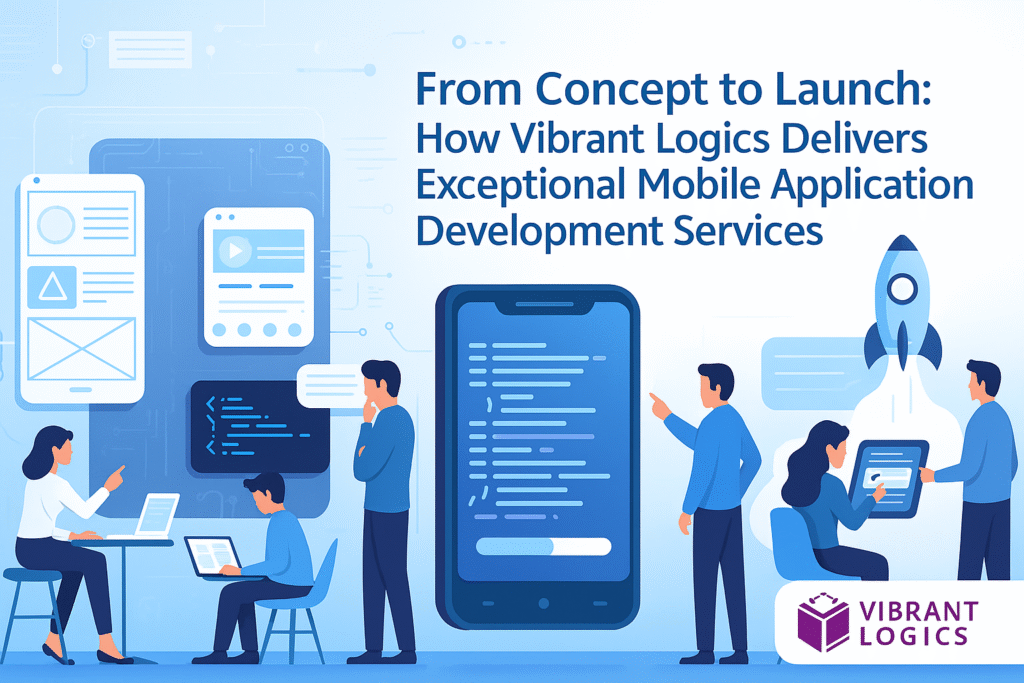
Building a mobile app isn’t just about coding. It’s about turning an idea into a functional product that users love. Mobile Application Development Services involve planning, designing, developing, testing, and launching apps that solve real problems. Vibrant Logics specializes in delivering end-to-end solutions that transform business concepts into market-ready applications. With 18-week average delivery timelines and expertise in both native and cross-platform development, the company handles projects from initial brainstorming to post-launch support.
What Happens During the Discovery Phase?
The discovery phase identifies project requirements and business goals. Vibrant Logics conducts stakeholder interviews, competitor analysis, and technical feasibility studies during this stage. The team documents feature lists, user personas, and platform requirements (iOS, Android, or both). This phase typically takes 2-3 weeks and prevents costly changes later in development.
Key activities include:
- Defining target audience demographics
- Mapping user journeys and pain points
- Establishing budget parameters
- Setting measurable success metrics
Discovery outputs inform all subsequent development decisions. Teams create project roadmaps with milestone dates and resource allocations.
How Does UI/UX Design Impact App Success?
Effective UI/UX design determines whether users continue using an app after download. Vibrant Logics designs interfaces based on platform-specific guidelines—Material Design for Android and Human Interface Guidelines for iOS. The design phase includes wireframing, prototyping, and user testing before any code gets written.
Design deliverables include clickable prototypes that stakeholders can test. Designers focus on intuitive navigation patterns, accessible color contrasts, and thumb-friendly button placements. Poor design causes 88% of users to abandon apps after one use, making this phase critical for retention.
What’s the Difference Between Native and Cross-Platform Development?
Native apps are built specifically for one operating system using platform-specific languages (Swift for iOS, Kotlin for Android). Cross-platform apps use frameworks like React Native or Flutter to run on multiple systems from a single codebase.
Native development offers:
- Superior performance for graphics-intensive apps
- Full access to device hardware features
- Better integration with OS-specific functions
- Optimized user experience per platform
Cross-platform development provides:
- Faster time-to-market across platforms
- Lower development costs
- Easier maintenance with unified codebase
- Suitable for business apps and MVPs
Vibrant Logics recommends native development for gaming, AR/VR, and high-performance apps. Cross-platform works well for e-commerce, booking systems, and content delivery apps where speed and budget matter more than cutting-edge device features.
How Long Does Development Actually Take?
Development timelines depend on feature complexity and integration requirements. A basic app with standard features takes 12-16 weeks. Apps requiring custom APIs, real-time features, or complex backend systems need 20-28 weeks. Vibrant Logics maintains an 18-week average delivery time by using agile methodology with two-week sprints.
Timeline breakdown for standard projects:
- Discovery and planning: 2-3 weeks
- UI/UX design: 3-4 weeks
- Frontend development: 6-8 weeks
- Backend and API development: 4-6 weeks
- Testing and QA: 2-3 weeks
- Deployment and launch: 1 week
Parallel workflows reduce total time. Designers create later screens while developers build initial features. Backend teams work simultaneously with frontend teams using API documentation.
What Testing Methods Ensure App Quality?
Quality assurance prevents crashes, security vulnerabilities, and poor user experiences. Vibrant Logics conducts functional testing, performance testing, security audits, and user acceptance testing before launch. Automated testing tools check code integrity during development, while manual testers validate real-world usage scenarios.
Testing covers:
- Device compatibility across manufacturers
- OS version compatibility
- Network condition variations (3G, 4G, 5G, WiFi)
- Battery consumption patterns
- Memory usage optimization
Security testing identifies data vulnerabilities and prevents unauthorized access. Penetration testing simulates attack scenarios to strengthen defenses. Apps handling financial transactions or personal health data undergo additional compliance audits.
How Do Apps Get Submitted to App Stores?
App store submission requires meeting platform-specific guidelines and preparing marketing assets. Apple’s App Store has stricter review processes than Google Play, often taking 24-48 hours for initial review. Google Play reviews typically complete within hours but can extend to days for complex apps.
Submission requirements include:
- App icon in multiple sizes
- Screenshots for various device sizes
- Privacy policy URL
- App description optimized with keywords
- Age rating selection
- Pricing and availability settings
Vibrant Logics handles submission processes, addressing reviewer feedback and resubmitting if needed. The team prepares contingency plans for potential rejections and knows platform-specific appeal processes.
What Happens After Launch?
Post-launch support ensures apps remain functional as operating systems update. Vibrant Logics monitors crash reports, user reviews, and performance metrics immediately after launch. The first week reveals critical bugs that didn’t surface during testing due to real-world usage patterns and diverse device configurations.
Ongoing maintenance includes:
- OS compatibility updates
- Security patches
- Bug fixes based on user reports
- Performance optimization
- Feature additions based on user feedback
Analytics integration tracks user behavior, retention rates, and conversion funnels. This data informs update priorities and feature roadmaps. Apps without regular updates lose visibility in app stores and accumulate negative reviews.
Why Do Some Apps Fail Despite Good Development?
Technical excellence doesn’t guarantee market success. Apps fail when they solve problems nobody has, launch without marketing strategies, or ignore user feedback post-launch. Market research during discovery phase prevents building apps for non-existent audiences.
Common failure factors:
- Insufficient user testing before launch
- Poor onboarding experiences that confuse users
- Monetization models that frustrate users
- Lack of differentiation from competitors
- Inadequate marketing budget allocation
Vibrant Logics addresses these risks by validating business models during discovery and recommending phased feature releases. MVP launches test market response before full feature investment.
How Much Do Mobile Application Development Services Cost?
Development costs vary based on complexity, platform choice, and feature requirements. Basic apps with standard features cost less than apps requiring custom animations, real-time data sync, or AI integration. Native development for both iOS and Android costs more than cross-platform development but delivers superior performance.
Cost factors include:
- Number of user roles and permissions
- Third-party service integrations
- Custom backend infrastructure needs
- Advanced features like AR, video streaming, or offline functionality
- Geographic location of development team
Vibrant Logics provides transparent pricing based on detailed project scoping. The company breaks costs into phases, allowing clients to launch MVPs before committing to full feature sets. This approach reduces financial risk while validating market demand.
What Makes Vibrant Logics Different?
Most development agencies either excel at design or coding but rarely both. Vibrant Logics combines technical expertise with business understanding, ensuring apps meet both user needs and business objectives. The 98% first-visit resolution rate and 15-minute response time for client queries demonstrate operational efficiency beyond coding skills.
The company signs NDAs before project discussions, protecting intellectual property throughout development. This confidentiality extends to competitive research and proprietary algorithms. Clients receive full code ownership and documentation upon project completion.
Conclusion
Mobile app development requires coordinating design, development, testing, and launch activities while managing timelines and budgets. Success depends on choosing the right technology stack, maintaining quality standards, and planning for post-launch evolution. Apps that solve real problems with intuitive interfaces capture market share regardless of competition.
Ready to transform your app idea into reality? Vibrant Logics brings together strategic planning, technical execution, and unwavering commitment to deadlines—delivering apps that users actually open more than once. With a proven 18-week delivery track record and comprehensive support extending beyond launch day, your concept gets the attention it deserves from professionals who understand both code and commerce. Stop browsing development agencies that promise the moon but deliver craters. Schedule a consultation at vibrantlogics.com/mobile-application-development and discover why 2,500+ clients trust our process from that first sketch on a napkin to your app sitting pretty in the App Store.

